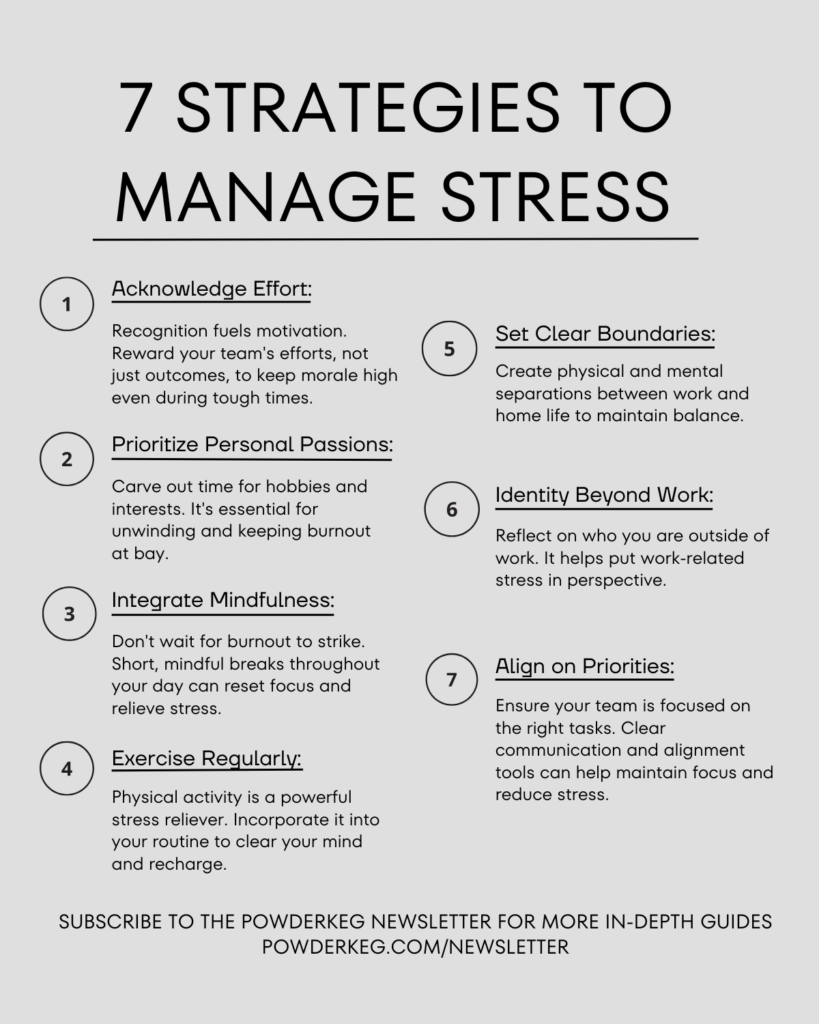As leaders, work is a big part of our lives. It shapes us, shakes us up, and sometimes, stresses us out.
Managing workplace stress is climbing up the to-do list, even catching the eye of the US Surgeon General’s top priorities. And when you peek at the numbers, it’s easy to understand why:
- 76% of U.S. workers reported at least one symptom of a mental health condition.
- 84% of respondents said their workplace conditions had contributed to at least one mental health challenge.
- 81% of workers reported that they will be looking for workplaces that support mental health in the future.
“Most of our brains are meant to mind wander, to think of all the things that could happen,” Dr. Alicia Mckoy said in a recent podcast interview with Powderkeg.“A focused brain gets things done, right? A mind wandering brain is a stress brain, a focused brain is a productive brain.”

We talked with several other CEOs and Executives in the Powderkeg community about building a healthy workplace culture and managing stress at a scaling tech company.
Let’s take a look at their playbooks for keeping stress low so their leaders and teams can thrive.
Learn These 7 Strategies to Manage Stress and Build a Healthy Workplace Culture:
Here are their best practices on making work a place where everyone’s set up to win.
1. Always Recognize Team Members for Their Effort
 To buffer excessive stress at my company, I recognize and reward team members for process goals that are within their control. Lots of times when companies go through rough patches, they stop being recognized so much for winning. This cuts off their team’s access to dopamine, the molecule that motivates us. Then the team starts running off the stress hormones, cortisol and adrenaline, which leads to burnout. But if you continually recognize your team for effort, it keeps the dopamine flowing.
To buffer excessive stress at my company, I recognize and reward team members for process goals that are within their control. Lots of times when companies go through rough patches, they stop being recognized so much for winning. This cuts off their team’s access to dopamine, the molecule that motivates us. Then the team starts running off the stress hormones, cortisol and adrenaline, which leads to burnout. But if you continually recognize your team for effort, it keeps the dopamine flowing.
Kevin Bailey, Co-Founder & CEO at Dreamfuel
2. Schedule Time for Personal Passions
 It’s easy at fast-paced companies to get burned out if you’re not intentional about unwinding. Blocking out evenings or weekends for hobbies like art classes, hiking trips with friends, or tinkering on a side project gives you something exciting to break up your week. Having that set time to switch gears fully prevents stress from building up.
It’s easy at fast-paced companies to get burned out if you’re not intentional about unwinding. Blocking out evenings or weekends for hobbies like art classes, hiking trips with friends, or tinkering on a side project gives you something exciting to break up your week. Having that set time to switch gears fully prevents stress from building up.
Juliet Dreamhunter, Founder & AI Strategist at Juliety
3. Take Mindfulness Micro-Breaks
 Instead of waiting until burnout strikes, I integrate short moments of mindfulness throughout my day. Whether it’s taking a few deep breaths between tasks, going for a brief walk outside, or simply closing my eyes for a moment of reflection, these micro-breaks help reset my focus and alleviate tension.
Instead of waiting until burnout strikes, I integrate short moments of mindfulness throughout my day. Whether it’s taking a few deep breaths between tasks, going for a brief walk outside, or simply closing my eyes for a moment of reflection, these micro-breaks help reset my focus and alleviate tension.
Ashwin Ramesh, CEO at Synup
4. Get Regular Exercise
 Incorporating exercise into my daily routine has been my go-to strategy for managing stress in a fast-paced work environment. Whether it’s a brisk walk in the morning or a workout session after work, physical activity helps me clear my mind and reduce tension. It acts as a physical outlet for stress, leaving me feeling more relaxed and ready to tackle challenges.
Incorporating exercise into my daily routine has been my go-to strategy for managing stress in a fast-paced work environment. Whether it’s a brisk walk in the morning or a workout session after work, physical activity helps me clear my mind and reduce tension. It acts as a physical outlet for stress, leaving me feeling more relaxed and ready to tackle challenges.
Phil Strazzulla, Founder at SelectSoftware Reviews
5. Create Boundaries Between Work and Life Outside of Work
 Set good boundaries by creating “dividers” between work and life outside of work. Even though I work at home, my computer rarely leaves my office. When I walk out of my office, I shut the door so it’s not as easy to jump back in. I’ll even intentionally shut down my computer to increase friction in the process of jumping back in.
Set good boundaries by creating “dividers” between work and life outside of work. Even though I work at home, my computer rarely leaves my office. When I walk out of my office, I shut the door so it’s not as easy to jump back in. I’ll even intentionally shut down my computer to increase friction in the process of jumping back in.
Mike Bal, Product Leader at The Engineered Innovation Group
6. Focus on Your Identity Beyond Work
 Reflection on my identity beyond work is critical for me. I can sometimes get into a trap of equating myself with my work, but when I am able to remove that mindset – it is freeing. It puts life in perspective beyond the day-to-day work that can feel like a grind.
Reflection on my identity beyond work is critical for me. I can sometimes get into a trap of equating myself with my work, but when I am able to remove that mindset – it is freeing. It puts life in perspective beyond the day-to-day work that can feel like a grind.
Jackson Troxel, Vice President of Sales + Marketing at Multiply Technology
7. When At Work, Keep Your Team Aligned On Priorities
 Alignment on priorities is always critical, but especially critical in periods of high-growth, and especially in distributed organizations. We started with a weekly touchpoint with our founders and a Trello board and we still use it today (7+ years later). Pick the tools and the times to align and communicate out that are appropriate for your company size and needs. And stick to it!
Alignment on priorities is always critical, but especially critical in periods of high-growth, and especially in distributed organizations. We started with a weekly touchpoint with our founders and a Trello board and we still use it today (7+ years later). Pick the tools and the times to align and communicate out that are appropriate for your company size and needs. And stick to it!
Rick McGlinchey, Co-Founder at PureInsights
As ADVISA CEO Heather Haas said at Powderkeg’s Mental Performance Summit, “We exist to create effective teams, leaders and cultures because we believe everyone deserves the opportunity to thrive at work. So we all spend a lot of time at work and it should be a place where we’re both cared for and challenged to be our best selves.”

Implementing Strategies to Manage Stress and Build a Healthy Workplace Culture
Managing stress in a high-growth environment isn’t just about individual resilience; it’s about crafting a workplace culture that promotes balance, recognition, and alignment.
By adopting these best practices, leaders can create an environment where work-life balance is a daily reality. And in doing so, you can help set a new standard for what it means to thrive at work.
This post was contributed to by members of Powderkeg Executive Councils, the only private membership network designed exclusively for tech companies and executives looking to grow and connect beyond the confines of Silicon Valley. Apply today to join.



